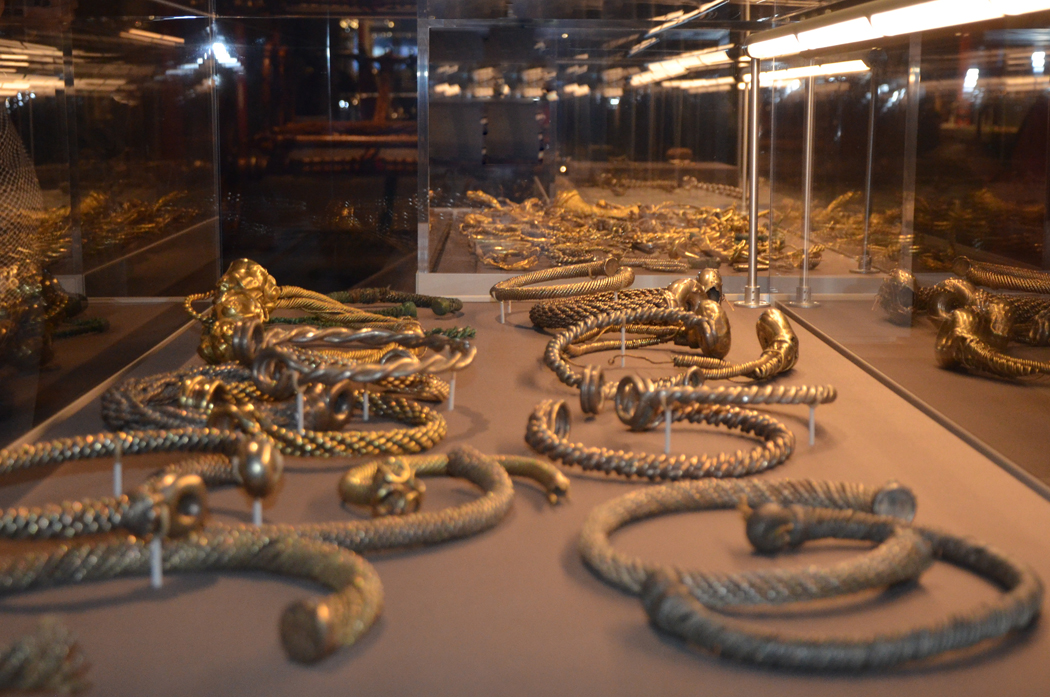“There never was a single pan-European ancient people called the Celts; there was no single culture; there was no single language”. This is the central statement the exhibition – Celts Art and Identity – wishes to make. We might question it, though.
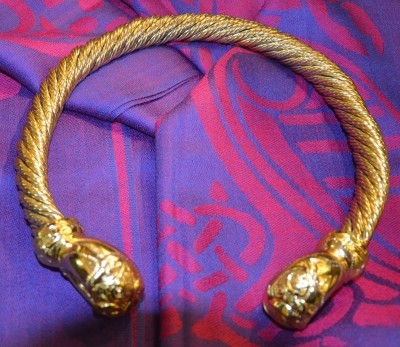
There is no doubt: The Celtic exhibition at the British Museum is full of exquisite eye-candy and well worth a visit. It is simply impossible to walk around without being totally astounded by the breath-taking details of all the pieces of art, which have been so carefully sourced, curated and exhibited. Knowing that this is just a small selection of the treasures, which might have been loaned from wider European collections, makes it even more astounding. To this should be added a carefully chosen selection of later Celtic treasures from Early Medieval Ireland and Scotland plus a humorous selection of Victorian neo-Celtic trash and treasures and we get a good overview of the constant renegotiation of the artistic legacy of the Celts, which has been going on since 500 BC and up until our time. Simply put: a lot to look at, details to enjoy and perhaps even be inspired by.
There is, as everyone knows, a huge Celtic industry catering for people living in the periphery of modern society trying to connect to their pre-modern past. There is no doubt, they will swarm the British Museum in days to come and warm to the many artefacts offering inspiration on all levels. Afterwards, there is a whole shop filled with books, arts and crafts which can be perused and shopped for plus loads and tons of neo-Celtic jewellery to buy. For £199 you may even get a copy of the famous ‘Snettisham Great Torc’, which is at the centre stage of the exhibition (together with many more torcs; see below).
Beneath the Glitter
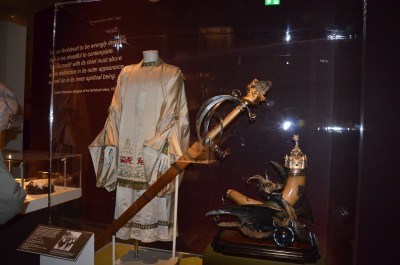
An educated guess is that most visitors seeing the exhibition will enjoy themselves hugely. But some might find it disconcerting and perhaps also disorientating. The reason may be found in the overall way in which the goodies have been framed.
At the entrance we are met with a grandiose display of such iconic items as the Queen Mary Harp from 1450 and a banner from a collection of Welsh Druid regalia from 1896. At the exit we leave with Celtic music streaming from a video showing snippets of people performing so-called Immaterial ‘Celtic’ heritage.
Thus the tone is set from the beginning. This is emphatically NOT an exhibition about the history of ‘the life and times of the Celts’ from 500 BC to present times. The whole idea of the exhibition has rather been to unpack the idea of the ‘Celtic’ and reduce it to an epithet connoting a particular artistic expression, which has been subjected to a multitude of historical and political re-negotiations over time.
It is of course also as such it should be reviewed. Does it live up to its intentions? Are we convinced? Are we any wiser at the end?
The Roots
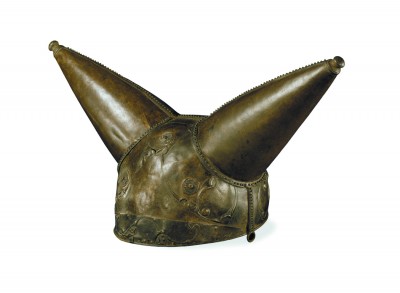
But first a bit about the general subject of the exhibition: Celts and their art and identity.
Around the turn of the fifth century BC the artistic expression among people living north of the Mediterranean region changed significantly. In the later Bronze Age and earlier Iron Age (c. 1250 – 600 BC), simple geometric patterns had dominated. However, around 500-400 BC a new artistic expression surfaced among people living there. The Greeks called these people the “Celtoic”, but it is not known whether the people in question used this word themselves. However, the word does not have Latin or Greek roots and it might just possibly have been their own eponym.
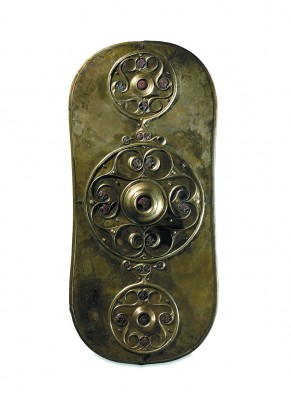
One of the main features was that highly skilled artists began to excel at creating individually distinct objects – at first weapons, shields, decorations on chariots, drinking vessels and not least the ubiquitous torcs. These objects were decorated with intricate swirling patterns, fantastic renderings of animals and sometimes inlaid with corals or glass. Often abstract and ambiguous it has obviously for a long time been an academic specialty – in German called Keltologie – to try and decipher, what it all might mean.
Later, Celtic art morphed into a more plain artistic impulse. At this point brooches came to dominate, while early Christian liturgical artefacts like processional crosses, reliquaries and books were destined to reinvent the artistic legacy at a higher level.
Finally – from 1500 and onwards a neo-Celtic revival took place venerating the historical roots of the Gaelic-speaking people of Wales, Cornwall, Ireland and Scotland though this artistic legacy.
It stands to reason this artistic expression took many forms through 1500 years and across most of Western Europe. Nevertheless, it is possible to identify a specific artistic legacy as ‘Celtic’. We know it, when we see it. It is this, which we generally denote with the epithet, ‘Celtic’; and which curiously enough have endured until our days, even though its meanings and contexts have changed over time.
To be ‘Celtic’ was and is thus to adopt this recognizable artistic expression and use it to express cultural difference. First this artistic staging was part of a ‘conversation’ with he Greeks and Romans; later it was found to be conversing with the pagan Anglo-Saxons. And finally, today it is conversing with modernity and post-nationalism. It is those conversations, which are the explicit subject of the exhibition.
“The word Celtic still resonates powerfully today because it has been redefined in response to contemporary debates about politics, religions and identity”, it says on a poster. So far so good!
But we may add: To be Celtic was always also to live on the fringe of civilised society!
Aestheticization of Culture
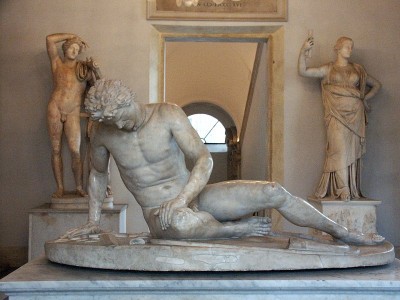
Unfortunately the curators have disregarded the fact that such a position – on the fringe – is never just a question of aesthetics. What is also at stake, is – will the anthropologists tell us – some kind of cultural posturing. The whole point is in fact that people, who live life on the fringes will claim that they are carrying a specific culture as opposed to those, who are located at the powerful centre, who will live in a ‘natural and civilized’ way devoid of ‘culture’ as such. Just think about it: culture is something, which characterises the “others”; we, on the other hand, live a normal and natural – modern – life at the centre of the world, where everything is as it should be. Those with ‘culture’ live in the ghettos, in the countryside or in the Outer Hebrides.
It is obvious that art plays a different role in such different life situations. At the exhibition and in the catalogue we see this played out perfectly, when two sculptures are opposed.
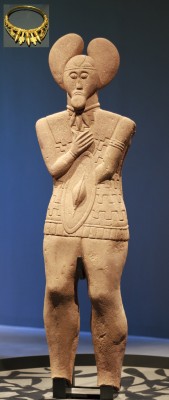
One is the famous sculpture, “The Dying Gaul” also called the “Dying Galatian” (Galatian meaning Celt). The original sculpture was probably executed between 230 – 220 BC by Epigonus. We know of it from a copy which was probably gifted to Caesar after his victory in Gaul and which is one of the star attractions in the Capitoline museum (I still remember seeing it for the first time more than 50 years ago). A photostat may be seen of the sculpture at the exhibition, but it is also rendered in the introduction to the catalogue.
The other sculpture is the Glauberg Statue, which was erected upon a grave around 450 – 400 BC at Glauberg in present day Germany. At the exhibition a copy of the statue may bee seen. What is unfortunately not exhibited is the torc, which was found around the neck of the dead young man, who had been buried directly beneath the statue. The amazing fact is that this very unique torc does not look like anything else, except the torc, which is embellishing the neck of the statue. Archaeologists believe the statue is in fact a personal rendering of the man below.
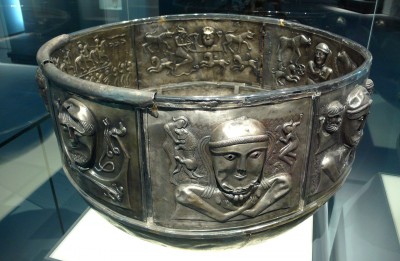
This opens up for understanding the different ways in which art is used at any centre and in any periphery. At the centre art is natural, modern and dismembered form any other role than being evocative and aesthetically pleasing. Art is something, which you place in your gallery, hang on your wall or listen to at a concert; and which you qualify according to how much it “touches” you. As did the Romans! Art in the periphery plays quite a different role: here it is decorative, designed to embellish persons, rituals and artefacts, setting them apart y staging their specific way of life (or culture) as ‘different’.
What we see at the exhibition are a lot of such different ‘decorated’ objects, which were obviously used to express ‘otherness’ and being culturally apart(e). But we are specifically not told what these objects in general might mean – what the decoration so to speak covers up.
Or to say it differently: there is no explanation of what was filled into the large cauldrons: a sacrificed man, perhaps, as may be seen in a relief at the Gundestrup cauldron? Or just large communal brews accompanying grilled beasts prepared at the famous roast spit, (which has been left desolate up in the ‘Celtic’ gallery on the third floor in the British Museum)?
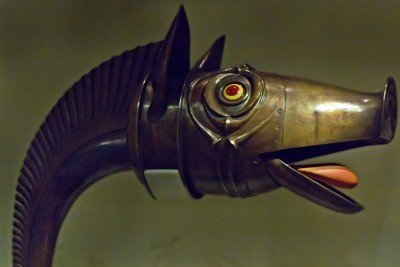
We get a few hints of this common cultural denominator in the exhibition, but not many; and the catalogue certainly does not deliver the full story of the very specific warrior-culture, which developed in contact with the Mediterranean city-states, and which created a specific culture around a number of key-elements: the torcs, the weapons and the chariots primarily found in graves with weapons (and hence not just something ‘used for transport’ as the exhibited reconstruction and the rubric in the catalogue – Traveling in style – seem to wish to convey). Lost is the vivid drama, which a more anthropologically inclined understanding of the Celtic world might have given us; instead we are presented with an anaemic, curiously ‘flat’ understanding of what being Celtic in the last centuries BC was all about: art, bronze and gold.
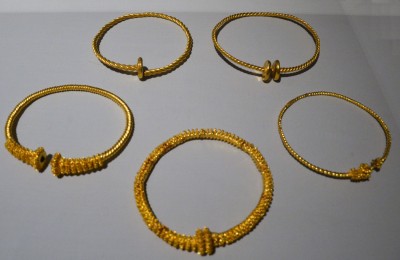
Moreover, the idea is constantly peddled that the diversity of this ‘art’ was if anything else an important sign of the diversity of culture of the people, who crated and lived with the art.
“Look”, exclaims Julia Farley, the curator of the exhibition “how different all these torcs are”. Yes, I answer “but what is the common denominator: They are all torcs”. Or to take another example: the exhibition shows both the original Deskford Carnyx and a reconstruction of it as well as the Gundestrup Couldron, which famously show three persons blowing their Carnyxes at a military parade; but ‘forgets’ to tell that carnyxes have been found in modern Britain, Scotland, France, Germany, Romania and Switzerland and that the cauldron, which was probably made in present day Bulgaria at some point was brought from there to be buried in a bog in Northern Jutland. There is no doubt that these people at a structural level lived in the same cultural world even if that should not in any way imply that they were racially or even linguistically connected. And yes, this is pointed out in the accompanying texts, but this information drowns in the overall setting.
And yet, art is never innocent!
Repercussions
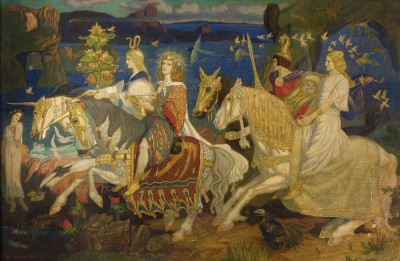
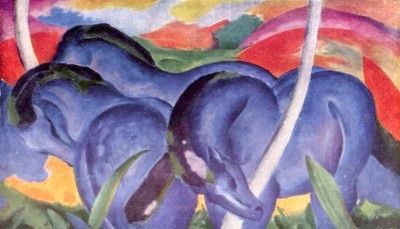
All this has unfortunately also repercussions for the next two parts of the exhibition: the one showing artefacts from Early Christian Ireland and Scotland and the third part, which tells the story the Celtic revival after AD 1500. Again we see series of beautiful objects more or less enigmatically decorated, but we are not offered an explanation of why they were designed to look exactly like this (and not different). We see the things and are overwhelmed by their exquisiteness; but are deprived of the cultural conversation, in which they took part. Just to make a start the painting on show by John Duncan from 1911, the Riders of the Sidhe, is here in this review shown together with a painting NOT shown at the exhibition, Die Grossen Blaune Pferde by Franz Marc, which was painted in the exact same year. Obviously John Duncan, who was a gifted painter made a choice not to paint as his contemporaries with a more modern inclination. Why, we may ask…
It would have been nice to get what in anthropological or sociological parlance is generally termed as ‘the discursive context’. Through this we might have understood much more about the exquisite pieces of art, which have so lovingly been sought out and exhibited.
Political Project
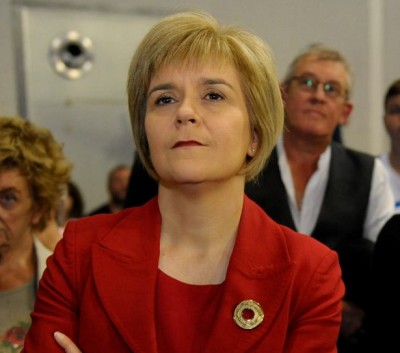
Instead we are invited as – perhaps unwilling – guests to a political party, where only soft and bland drinks are served.
“The British Museum is an educational institution, tells Julia Farley, who has curated the exhibition and goes on to explain how she eventually warmed to the idea of doing a deconstruction of ‘The Celts’ by following the shifting connotations of the ‘word’ rather than exhibiting the ‘way of life of the Celts’ at any time. The point was and is, of course, that the fundamental premise was, that there never was such a “thing” as a Celtic people or Celtic culture or Celtic language (as it is unequivocally written in the catalogue).
For her as well as her team and collaborators at the National Museum of Scotland the hope has seemingly been to avoid that anyone should believe – after having visited the exhibition – that there ever existed such a thing as a ‘Celtic People’.
However, this is no minor thing. By placing the British Museum with all its ‘colonial connotations’ behind this message, the curators and organizers may – perhaps unwillingly – have turned the exhibition into a daylight piece of ‘cultural identity-theft’.
The point is, of course, that the people at the so-called Celtic fringe do exactly this: understand themselves as ‘Celtic’. Which, in fact, makes them exactly that. Deconstructing and reducing their Celtic eponym to an artistic misnomer is not very kind at a time when the political periphery in Great Britain is busy explicitly staging itself as ‘Celtic’ in opposition to a government politically and culturally sited at Whitehall.
Make no mistake: Sturgeon wore a replica of a Celtic brooch on the night, when the Scots waited for the results of the Scottish referendum. One wonders why this photo is not shown at the present exhibition next to the druid robes and regalia shown at the end.
Or would that be even too much for British Museum to dare…?
VISIT:
Celts. Art and Identity
British Museum in London
24.09.2015 – 31.01.2016
The exhibition is organised with National Museums Scotland and will shown in a slightly different version in Edinburgh from March 2016.
SOURCES (a selection):
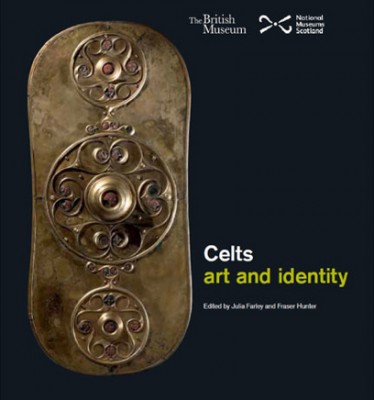 Celts. Art and Identity
Celts. Art and Identity
Ed. by Julia Farley and Fraser Hunter
The British Museum 2015
ISBN: 978 0 7141 2836 8
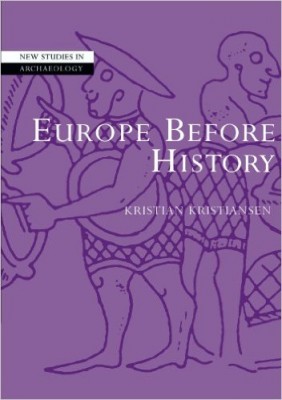 Europe Before History
Europe Before History
By Kristian Kristiansen
Cambridge University Press 1998
ISBN: 9780521784368
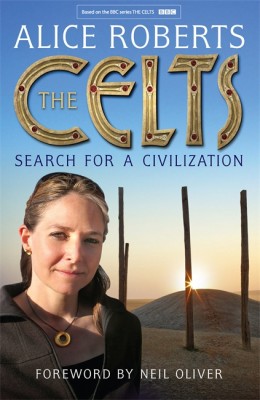 The Celts. Search for a Civilization.
The Celts. Search for a Civilization.
By Alice Roberts.
Heron Books 2015
ISBN-10: 1784293334
ISBN-13: 978-1784293338
The Celts accompanies a substantial BBC series presented by Alice Roberts and Neil Oliver, and showing in October 2015.
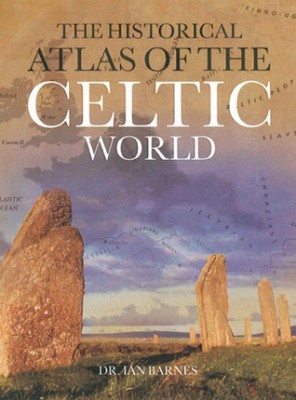 Historical Atlas of the Celtic World
Historical Atlas of the Celtic World
by John Haywood (Author), Barry Cunliffe (Foreword)
Thames & Hudson 2009
ISBN-10: 0500288313
ISBN-13: 978-0500288313
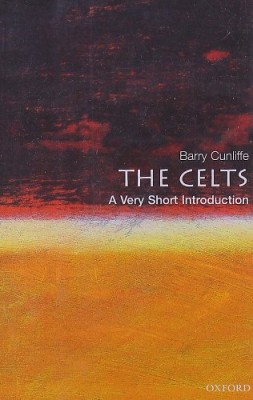 The Celts: A Very Short Introduction
The Celts: A Very Short Introduction
by Barry Cunliffe
Oxford University Press 2003
ISBN-10: 0192804189
ISBN-13: 978-0192804181
READ MORE:
Distinction. A Social Critique of the Judgement of Taste
By Pierre Bourdieu,
Routledge 1986 ( Original publication in French: 1979)
ISBN: 0-415-04546-0
Cultural identity and Global Process
By Jonathan Friedman
Sage 1994
ISBN: 0-8039-8638-6
SEE AND HEAR MORE
Behind the scenes with Celtic objects: a live Periscope tour with curators showing off the Snettisham Great Torc and sounding the Deskford Carnyx.
